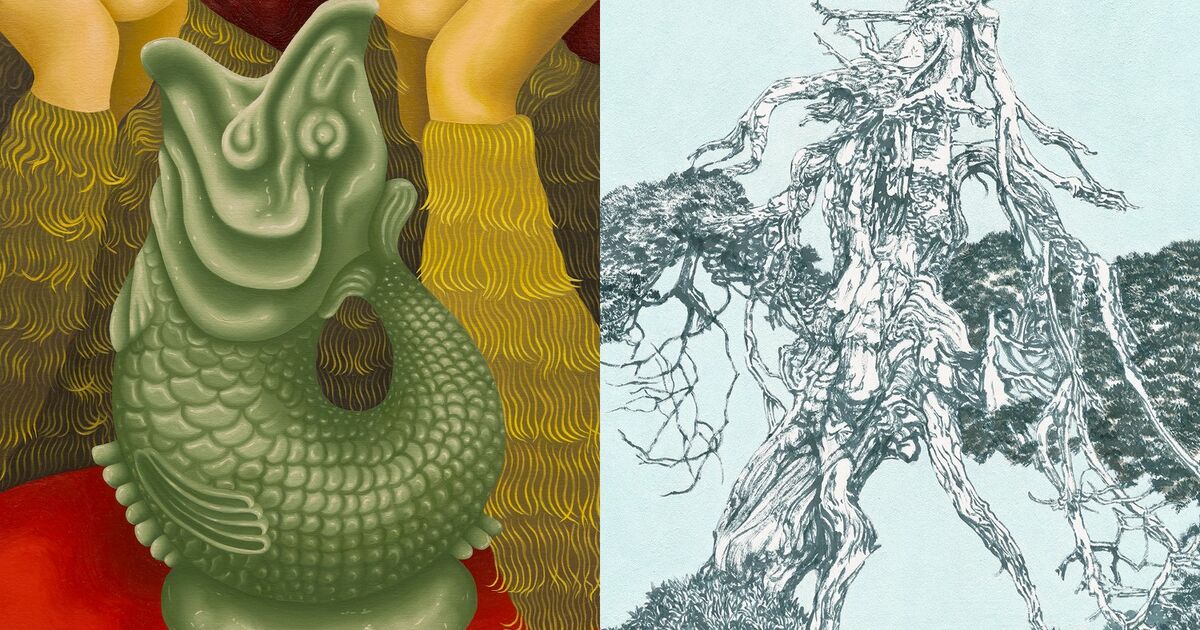Art
Maxwell Rabb
In this monthly roundup, we shine the spotlight on five stellar exhibitions taking place at small and rising galleries worldwide.
1969 Gallery, New York
Nov. 2–Dec. 16
Living and working in New York City, María Fragoso Jara captures scenes that are teeming with life in her blood-red paintings. In these suspenseful moments, animals, humans, and plants are captured mid-movement, as if eternally paused. Her work, alive with crimson hues and symbolic influence, invites viewers into a realm of mystery, passion, and sensuality, weaving together complex and emotionally resonant narratives.
Her second solo exhibition at 1969 Gallery, “Bodas de Sangre,” comprises eight paintings, six works on paper, and one sculpture. At the heart of the show is the triptych Hortus conclusu, Léa y María (2023), featuring two Mexican hairless dogs flanked by portraits of Fragoso Jara and her partner—in Aztec mythology, these dogs usher the dead into the afterlife. The triptych, featuring a red fence in the backdrop of each panel, evokes spiritual themes of death and immortality. These figures, with dogs as their ushers, exist in between the physical world as they evoke the spirituality of the afterlife.
Illuminati Fine Art, Hong Kong
Nov. 9–Dec. 8
In his new show at Illuminati Fine Art, “Sanctuary- Demeanour and Attitude/ Part II,” Taiwanese artist Tsung Jen Lee continues his painterly exploration of the alpine juniper tree. Born in Taiwan in 1966, the artist draws inspiration for this series from pastels made during the Qing dynasty and CongXian Wang’s photographs of juniper trees. In addition, a personal family struggle with cancer profoundly influenced his perspective, infusing his paintings of trees with a deeper emotional connection: Humans, too, have to fight against the odds. His continuous study of the spirit of these hardy trees, which grow in the harsh climate of the highest mountain regions of Taiwan, creates a thematic link between nature’s resilience and the artist’s own experience with personal tragedy.
Paintings such as Clouds and Crouching Tiger (both 2023) depict gnarled and weather-beaten trees sprawled out on the canvas. As if echoing the resilience of the human spirit, these junipers, set against intense hues, speak to the enduring strength of nature. Ultimately, Lee’s collection of paintings attempts to kindle a sense of hope and perseverance as he creates a sense of hardship and grace through these beloved trees.
Catinca Tabacaru Gallery, New York
Oct. 20–Dec. 10
For their third collaboration, curators Lesia Kulchynska and Catinca Tabacaru ask viewers to confront ongoing global emergencies head-on. Their group exhibition “State of Emergence” pulls together artists from Europe, Lebanon, Suriname, the United States, and Zimbabwe to place them in dialogue with Ukrainian artists, coinciding with the complex backdrop of the war in Ukraine.
Borys Kashapov’s Death Eats Death, Dancer Eats Death (2023), a massive graphite and charcoal illustration on canvas, is inspired by the destruction, depicting death as a chaotic abstraction. Meanwhile, Lesia Vasylchenko’s Tachyoness (2022) considers how nature and memory are influenced by digital media, in a video of overlapping sunsets that have been produced in collaboration with AI. Throughout the exhibition, artists engage with unsettling realities, bringing viewers’ attention to the disasters and changes happening around the globe, the results of which are often unknown and misunderstood.
“By featuring works from Ukrainian artists alongside established artists of Ukrainian origin and renowned international artists, we hope to bring Ukrainian perspectives on global issues and challenges to the forefront,” Anastasiia Manuliak, head of visual art for the Ukrainian Institute, wrote in a press release. “This inclusion of Ukrainian discourse in the vibrant art scene of New York City is an exciting opportunity to contribute to the artistic dialogue on a global scale.”
Swivel Gallery, New York
Nov. 18–Dec. 22
Louisiana-based artist Utē Petit creates a robust critique of colonialism, presenting an alternative to typical Western narratives in her first New York City solo exhibition. In “LusaHumma: Land of the Black Red,” Petit creates an alternative reality through drawings, sculptures, quilts, and installation works in which Black and Indigenous communities are able to reclaim their connection to the land. The works reflect on the brutal destruction of people and ideas that has occurred under a Eurocentric worldview.
Petit’s work, spanning from vibrant watercolors to graphite drawings, is a testament to suppressed cultures’ resilience as they withstand Western efforts to erase their history. Her visual storytelling serves as a platform for these often silenced voices, telling stories of healing, reconnection, and unyielding spirit. Her painting Red Bed Country (2023), for instance, depicts a crying person cowering beneath a shot buck, an intense vignette of threatened vitality. In affecting, sometimes challenging scenes, the artist captures the vitality of the oppressed. Throughout “LusaHumma,” she presents a new, edited depiction of the world to show that society’s evils exist barely beneath the surface.
Marissi Campos Gallery, Lima, Peru
Oct. 30–Dec. 30
Peruvian artist Martha Vargas pulls you into her dreams in her exhibition of new works, “Un Nuevo Amanecer” (“A New Dawn” in English). In these resin-based sculptures and medium-format oil paintings, Vargas focuses on surreal, richly colored scenes of ambiguous characters engaged in strange, dreamlike encounters. Her figures, recognizable by their round, anonymized faces, traverse an unfamiliar reality, filled with evocative objects: A reproduction of the central figure in Diego Velázquez’s Las Meninas (1656) appears in La Hacedora de Ilusiones (2023), for example, and Mickey Mouse, Super Mario, and emoji float around the top of the painting.
Elsewhere, in Esperanza (2023), the artist portrays several of her characteristically rotund figures with animal masks, wings, and other strange costumes, merging realistic and fantastical elements. The influence of Surrealists like René Magritte is clear, with some figures floating, and another with its head in the clouds, topped by tiny houses.
Maxwell Rabb
Maxwell Rabb is Artsy’s Staff Writer.

